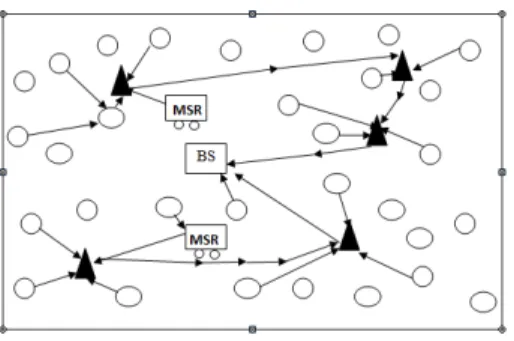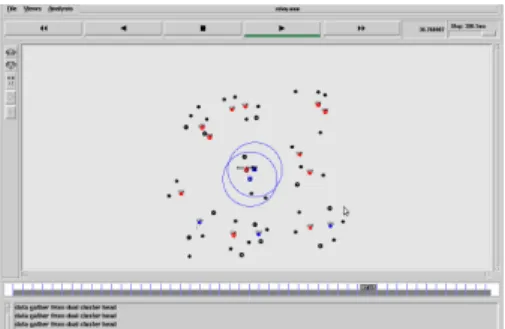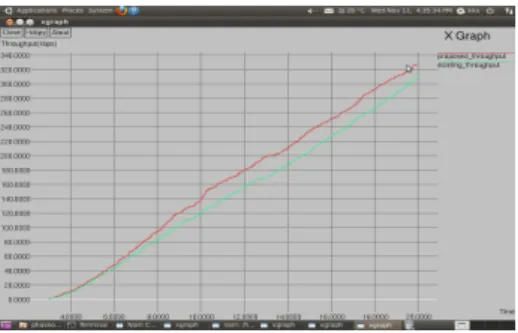AUSTRALIAN JOURNAL OF BASIC AND
APPLIED SCIENCES
ISSN:1991-8178 EISSN: 2309-8414 Journal home page: www.ajbasweb.com
Open Access Journal
Published BY AENSI Publication
© 2016 AENSI Publisher All rights reserved
This work is licensed under the Creative Commons Attribution International License (CC BY).
http://creativecommons.org/licenses/by/4.0/
To Cite This Article: M. Narender and K.R. Anjana Devi., Wireless Sensor Network Optimization using multiple Movable Sensors for Data Gathering. Aust. J. Basic & Appl. Sci., 10(1): 95-99, 2016
Wireless Sensor Network Optimization using multiple Movable Sensors for
Data Gathering
1M. Narender and 2K.R. Anjana Devi
1Department of Electronics and Communication Velammal Institute of Technology Panchetti , India 2Department of Electronics and Communication Velammal Institute of Technology Panchetti , India
Address For Correspondence:
M. Narender, 1Department of Electronics and Communication Velammal Institute of Technology Panchetti , India. E-mail: narender.malishetty@gmail.com
A R T I C L E I N F O A B S T R A C T Article history:
Received 10 December 2015 Accepted 28 January 2016 Available online 10 February 2016
Keywords:
Movable Sensor, Data Gathering
Mobile data gathering from a sensor network has a very wide range of applications. However, the heavy battery draining transmissions prove to be a limitation in every aspect for these highly useful networks. This paper demonstrates and explains the possibility of Mobile data gathering done using multiple "Movable Sensor (MSR)" - A moving sensor visiting and collecting date from each Cluster head in network, and delivering them in the sink. In the existing system, Load Balancing Cluster (LBC) Algorithm and Dual Data Uploading (DDU) techniques are used to gather the data, using a single Movable Sensor which is not optimizing the use of energy and data transmission capability in the Movable Sensor and cluster head. For enhanced optimization, we are using multiple Movable Sensors to gather the data. The Movable Sensors are equipped with higher energy capacities than the Cluster head. The multiple Movable Sensors each trace a unique path covering a distinct set of Cluster heads and gathering data from them. Hence the Cluster head life time is increased (as they now transmit only to the nearby Movable Sensor during its visit, rather than continuous transmitting to the farther Sink).We created a model of above explained technique, ran various stimulation under different scenarios and validated the effectiveness of the system.
INTRODUCTION
in the cluster head.
Previous models:
There are several algorithms which are used previously in WSNs to form a cluster with the cluster head and to collect the data from it. They are as follows:
a) Low energy adaptive clustering hierarchy (LEACH) in which the cluster head turns automatically with respect to certain preset conditions in such a way that it does not drain energy of a single node. The problem in this system is that it can only be used in networks which have only fixed nodes.
b) Energy efficient routing system for mobile networks, which divides the cluster group area and allots the header in such area. Header selected is a node which has least cost, low mobility and will also consider the energy of cluster head and number of nodes under the cluster head. The main disadvantage of this system is that there will be frequent disconnection due the different mobility value although they are nearer.
c) Load Balancing Cluster algorithm, which is used to select the cluster head where the mobility of node is higher. Initially the load balancing clustering algorithm is run to examine the energy level of the each cluster located in the network, then it will select the cluster head depending on the residual energy. If a node is located at a particular area without any neighboring nodes, it will act itself as the cluster head. This algorithm will be run in number of iterations, to select the cluster head. This algorithm also performs check on the optimal resource, and reduces overload of single resource.
d) Dual Data Uploading algorithm, which enables parallel transmission of the data from the cluster head to the MSR, in which both the cluster head and the MSR consists of two antenna to transmit the data. MSRs are a mobile data collector which is collecting the information from the cluster head and deliver it to the sink which is also called as the base station.
Wireless Sensor Networks With Msr:
In WSN, the main problem lies in how the MSRs visit each cluster head and collect and delivers data to the base station. Initially, MSRs were designed and could be used only in a single hop system, but it’s usage in a multi hop system will only be more beneficial.
The MSRs are commonly divided into two categories, they are:
a) Direct method, which uses the traveling salesman problem which will find the shortest path, the MSR will visit the node which is located nearer to the base station and then will visit the cluster head which is far away. The main problem in this is that the cluster heads which are located far from the base station and which also having low energy level will die before the MSR visits it and it may cause the loss of data.
b) Rendezvous planning (RP), which collects the data from the cluster head and delivers it to the base station before the expiry of end of deadline. The RP method is further classified into RP fixed path and RP unconstrained path. In RP fixed path, which is the linear method of data collection using MSR here the MSR which can only travel in one path and that path which is fixed. This method is not suitable for the wireless sensor network where the mobility of the node is higher. To overcome this problem the RP constrained method is used. This algorithm which is suitable for WSN where is high mobility of nodes and also which is used the proper use of the energy of the system.
Fig. 1: WSN ARCHITECTURE WITH MSR.
In the figure 1 CH means cluster head N means node MSR means mobile sensor.
Proposed System:
since in case of disconnection of one particular MSR from the network, sensors can still transmit their data towards other MSR, and the network continues to function.
Depending on the application requirements, a WSN with multiple MSRs can be divided into sub-networks, each of which is composed of a single MSR. In each of these sub-networks, data sources report their reading to the MSR of the cluster, and sensor nodes in the cluster relay messages sent by the sources towards the MSR.
In many deployment scenarios, mobile entities already exist in the deployment area, such as firemen in an emergency response application, and buses in a traffic monitoring application. The mobile nodes, which are capable of communicating with other nodes in the network, can address the connectivity problem by carrying information.
Initially polling points receives and stores the information from the sensor nodes, after filling the memory it sends a request to base station for sending the mobile controller devices.
Multiple Movable Sensor (MSR) devices in the wireless sensor networks the emergency case also implemented at the particular rendezvous point. Here, when the energy is decreased in the rendezvous point it sends the data to thee other rendezvous point which is nearer distance to the base station. Second rendezvous point directly sends the data to the base station.
Depending on the application requirements, a WSN with multiple MSRs can be divided into sub-networks, each of which is composed of a single MSR. In each of these sub-networks, data sources report their reading to the MSR of the cluster, and sensor nodes in the cluster relay messages sent by the sources towards the MSR.
In many deployment scenarios, mobile entities already exist in the deployment area, such as firemen in an emergency response application, and buses in a traffic monitoring application. The mobile nodes, which are capable of communicating with other nodes in the network, can address the connectivity problem by carrying information.
Initially polling points receives and stores the information from the sensor nodes, after filling the memory it sends a request to base station for sending the mobile controller devices. And also with the implementation of the multiple MSR devices in the wireless sensor networks the emergency case also implemented at the particular rendezvous point. Here, when the energy is decreased in the rendezvous point it sends the data to thee other rendezvous point which is nearer distance to the base station. Second rendezvous point directly sends the data to the base station.
MSR is always equipped with a high energy capacity than all the other components in a WSN. MSR surveys and collects sensed data directly from sensor nodes through cluster heads, and thereby help sensor nodes save energy that otherwise would be consumed by multi-hop communications.
Fig. 2: Multiple MSR gathering data from CH to BS.
In the figure 2, triangle shaped structure is cluster head and BS means base station and MSR means mobile sensor.
Implementation Of Proposed System:
Initially all nodes are created using network simulation using load balancing cluster algorithm the nodes itself will select its own cluster head depending on the residual energy
At the beginning of the execution, the cluster head will directly send the data collected from the cluster member the base station which is called as the Sink. We set a minimum residual value for the cluster heads, until which the transfer of data directly to sink without the need of MSR which shown in Figure 3. The black points indicate that the data is transferring to the sink; blue color hole like structure indicates the cluster head and other cluster member.
Fig. 3: Data transferring directly from the CH to BS.
In this a paper we are using multiple Movable Senor to reduce the latency level compared with the existing system. The clusters are grouped and divided two parts using the geographic algorithm. Two MSR will move to the different area to collect the data as shown in the Figure 4.
Fig. 4: MSR collecting data from the CH.
After collecting the data from the cluster head it will transfer the data to the base station which is shown in the Figure 5.
Fig. 5: MSR transferring collected data to the BH.
Performance Analysis:
Compared with the existing system the throughput of the proposed system is increased up to 40% due to the introduction of multiple Movable sensors (MSR) in the system which is shown in the figure 6. And also the packet size of data gahtering by the MSR is also increased to 50% which is shown in the figure 7.
Fig. 7:Throughput comparison graph.
Conclusion And Future Work:
For covering a large area and more number of nodes in the network, multiple mobile elements are used by separating the network into partitions for collecting data. This implementation is done by region based approach. In the case of node failure in the network (any emergency), the Movable Sensor (MSR) collects data immediately from that particular node.
The experimental results show us that in the proposed algorithms, the efficiency of sensed data collected by the base station in partitioned WSN is improved using multiple mobile elements.
The future works of this paper include Priority based Load balanced Clustering method for data gathering and recovery, collection of data from the failed sensor nodes in the WSNs.
REFERENCES
Networks Miao Zhao, Member, IEEE, Yuanyuan Yang, Fellow, IEEE, and Cong Wang, 2010. “Mobile Data Gathering with Load Balanced Clustering and Dual Data Uploading in Wireless sensor”, Ieee transactions on mobile computing, 14-4.
Naga Malleswari, P., G. Venkateswara Rao, 2013. “An Energy Efficient Virtual MIMO Communication for Cluster-based Wireless Sensor Networks”, International Journal of Engineering Research & Technology (IJERT), 2-4.
Kenan Xu, Hassanein, H. Takahara, G. Quanhong Wang, 20009. “Relay Node Deployment Strategies in Heterogeneous Wireless Sensor Networks Mobile Computing”, IEEE Transactions on, 9-2.
Ossama Younis and Sonia Fahmy, 2004. Department of Computer Sciences, Purdue University 250 N. University Street, West Lafayette, IN 47907–2066, US “Distributed Clustering in Ad-hoc Sensor Networks: A Hybrid, Energy-Efficient Approach” Published in INFOCOM. Twenty-third Annual Joint Conference of the IEEE Computer and Communications Societies, 1.
Cheng, W.C., C. Chou, L. Golubchik, S. Khuller, Y.C. Wan, 2004. “A Coordinated Data Collection Approach: Design, Evaluation, and Comparison,” IEEE J. Selected Areas in Comm., 22(10): 2004-2018.
Scaglione,. A. and S.D. Servetto, 2002. “On the Interdependence of Routing and Data Compression in Multi-Hop Sensor Networks”, Proc. ACM MobiCom.



